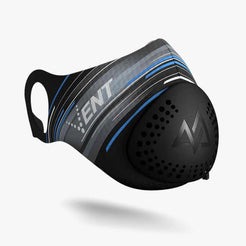In recent times, the widespread use of respiratory masks has become ubiquitous, primarily due to global health concerns such as the COVID-19 pandemic. While masks serve as a fundamental barrier against harmful airborne particles, the integration of mask filters significantly enhances their efficacy. This comprehensive guide delves into the realm of mask filters, elucidating their functionality, types, materials, and the pivotal role they play in augmenting respiratory protection.
1. The Essence of Mask Filters
Mask filters constitute an integral component of respiratory protection, serving as a secondary layer that traps and filters out contaminants present in the air. They are designed to complement the primary barrier of the mask, typically made of materials such as cloth, surgical fabric, or respirator-grade materials like N95. By capturing particles of various sizes, mask filters minimize the risk of inhaling harmful substances, including dust, allergens, pollutants, and pathogens like bacteria and viruses.
2. Types of Mask Filters
2.1 Mechanical Filters
Mechanical filters, also known as particulate filters, operate through physical mechanisms to block airborne particles. These filters comprise intricate networks of fibers or pores that effectively trap contaminants as air passes through. Common materials used in mechanical filters include polypropylene, fiberglass, and cellulose. They are highly efficient in capturing particles of varying sizes, ranging from large dust particles to microscopic pathogens.
2.2 Activated Carbon Filters
Activated carbon filters are renowned for their exceptional ability to adsorb and neutralize volatile organic compounds (VOCs), odors, and gases. These filters feature a porous structure with a vast surface area, allowing them to chemically bind with contaminants upon contact. Additionally, activated carbon filters may incorporate additional layers for mechanical filtration, offering comprehensive protection against both particulate matter and gaseous pollutants.
2.3 HEPA Filters
High-Efficiency Particulate Air (HEPA) filters represent the pinnacle of filtration technology, capable of capturing 99.97% of particles sized 0.3 micrometers or larger. Composed of ultra-fine glass fibers arranged in a dense mat, HEPA filters excel in removing microscopic particles, including bacteria, viruses, and allergens. They are commonly utilized in medical-grade respirators and air purifiers to ensure superior air quality and respiratory protection.
3. Materials Used in Mask Filters
3.1 Polypropylene
Polypropylene, a thermoplastic polymer, is extensively utilized in manufacturing mask filters due to its exceptional filtration efficiency, durability, and breathability. Its hydrophobic properties prevent moisture buildup, maintaining optimal filtration performance even in humid conditions. Moreover, polypropylene is cost-effective and can be electrostatically charged to enhance particle capture efficiency.
3.2 Fiberglass
Fiberglass filters are renowned for their high tensile strength and superior filtration capabilities. Composed of fine glass fibers arranged in a random orientation, fiberglass filters effectively trap particles while allowing unrestricted airflow. However, fiberglass filters may pose respiratory hazards if inhaled, necessitating proper encapsulation within the mask structure to prevent fiber release.
3.3 Activated Carbon
Activated carbon, derived from charcoal or carbonized materials, serves as a potent adsorbent in mask filters. Its porous structure facilitates the adsorption of gases, odors, and volatile compounds, ensuring enhanced respiratory comfort and protection. Activated carbon filters are often integrated alongside mechanical filtration layers to provide comprehensive defense against airborne contaminants.
4. Factors Influencing Filter Performance
4.1 Filtration Efficiency
Filtration efficiency denotes the percentage of particles captured by the filter relative to the total particles present in the air. It is influenced by various factors, including filter material, pore size, thickness, and electrostatic charge. Higher filtration efficiency ensures superior protection against airborne hazards, making it a critical consideration in filter selection.
4.2 Pressure Drop
Pressure drop, also known as resistance, refers to the reduction in airflow across the filter due to its inherent resistance to air passage. While efficient filtration is paramount, excessively high pressure drop can impede breathability and comfort, particularly during prolonged mask usage. Balancing filtration efficiency with minimal pressure drop is essential to optimize respiratory protection and user comfort.
4.3 Fit and Seal
The effectiveness of mask filters relies heavily on proper fit and seal to the face. Inadequate sealing compromises filtration efficiency, allowing unfiltered air to bypass the mask and enter the respiratory system. Ensuring a snug fit and proper seal minimizes leakage, maximizing the efficacy of the filter in capturing airborne contaminants and safeguarding respiratory health.
5. Applications and Considerations
5.1 Medical Settings
In medical settings, particularly in hospitals and clinics, mask filters play a pivotal role in preventing the transmission of infectious diseases among healthcare workers and patients. Respirators equipped with HEPA or N95 filters are commonly utilized to safeguard against airborne pathogens, including viruses such as SARS-CoV-2.
5.2 Industrial Environments
In industrial environments characterized by hazardous airborne pollutants, respirators with specialized filters offer essential protection to workers against dust, chemicals, fumes, and particulate matter. Employing appropriate filter types tailored to specific workplace hazards is imperative to mitigate respiratory risks and ensure occupational safety.
5.3 General Public Use
With the proliferation of airborne pollutants and infectious agents, the general public has increasingly embraced the use of masks with filters as a preventive measure. Cloth masks supplemented with removable filter inserts provide an accessible and effective means of enhancing respiratory protection in everyday settings, such as public transportation, crowded areas, and indoor spaces.
Conclusion
Mask filters represent a cornerstone in respiratory protection, augmenting the efficacy of masks in safeguarding against airborne contaminants. By employing diverse filtration mechanisms and materials, mask filters cater to a myriad of applications, ranging from medical and industrial settings to everyday use by the general public. Understanding the intricacies of mask filters, including their types, materials, and performance factors, is indispensable in optimizing respiratory health and mitigating risks posed by airborne hazards. As the global landscape continues to evolve, the role of mask filters remains paramount in ensuring a safer and healthier environment for all. Visit the official website of trainingmask.com

